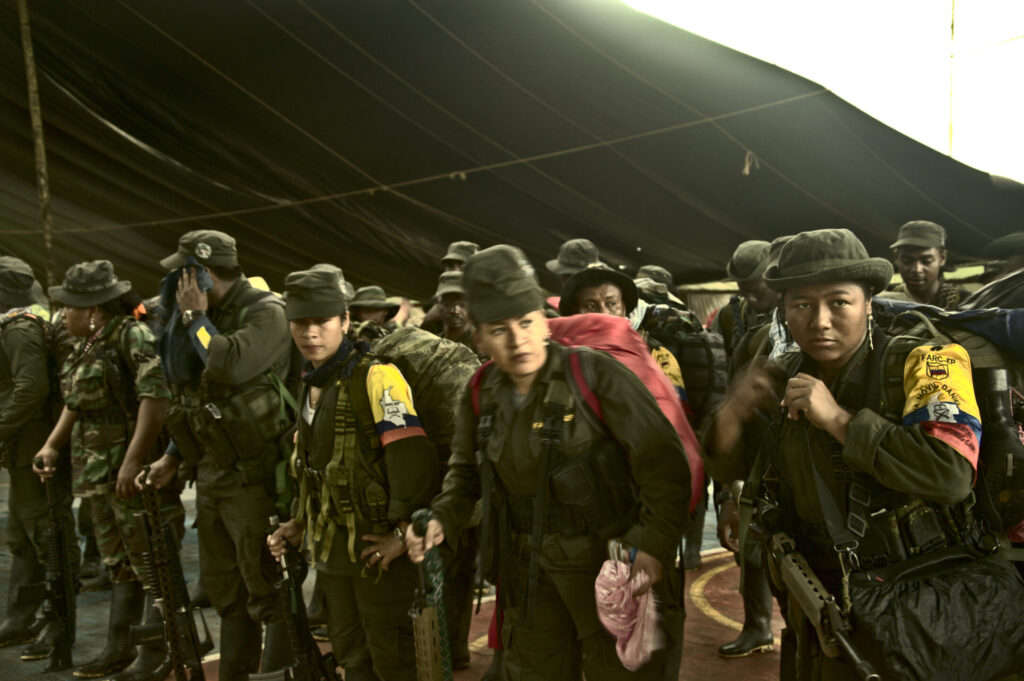In October, the Security Council met for its annual Women, Peace and Security (WPS) Open Debate under the theme of “Women Building Peace in a Changing Environment”. Despite the WPS’ goals to include women in all aspects of security and peace-making, their participation in disarmament, demobilization and reintegration (DDR) – a crucial part of peace processes – has often been minimal or merely symbolic.
The history and progress on the inclusion of women in DDR
Women combatants have historically been excluded from reintegration support and remain grossly underrepresented in DDR programmes. This is due to the assumption that men are the ones carrying the weapons and operating at the frontlines of armed groups. The programmes aim to prevent conflict recurrence by ensuring that weapons and ammunition held by non-state groups are collected and destroyed, command structures of armed groups are dismantled, and combatants transition to civilian lives through economic and social reintegration programmes.
Since the 1980s, DDR programmes have significantly evolved, from a narrow security focus to a broader agenda aimed at reconciling ex-combatants and communities and rebuilding the social and economic fabric of war-torn countries. Most recently, DDR has involved interventions in ongoing violence and the use of DDR tools, such as weapons and ammunition management and community violence reduction which can be deployed when the conditions for a “classic” DDR process are not in place. It is within this ever-changing and responsive agenda that an increased focus on women combatants has evolved over the decades.
Research examining 372 non-state groups between 1946 and 2015 found that 63% of these groups included women in some capacity. Women and girls participate in armed groups in many ways: as combatants, spies, smugglers, porters, translators, sex workers, wives, cooks, nurses, recruiters and communicators. But in 45% of the groups studied, women also held leadership roles. Accordingly, women associated with armed groups have diverse experiences, both in decision-making processes and in the use of violence.
Women’s involvement in conflict and peace processes is consequential. On the one hand, women combatants’ participation is associated with longer civil wars and voluntary participation in combat is associated with increased likelihood of rebel victory. On the other hand, women’s participation in peace negotiations is associated with a higher likelihood that peace agreements will endure. When involved in peace talks, women can help reconfigure the boundaries of negotiations, broadening the scope of what is relevant to security (e.g., issues related to sexual and gender-based violence) and the provision of social services for all affected populations. Lastly, research demonstrates that when women combatants’ are involved in peace processes they make it more likely that marginalized women’s grievances and the post-conflict needs of women ex-combatants are properly addressed.
Five steps for gender-responsive DDR
Several international mechanisms already recognize women’s varied conflict experiences and needs in DDR programmes. The UN Security Council Resolution 1325 explicitly calls on all parties involved in DDR processes to take into account the different needs of men and women ex-combatants. Subsequent resolutions stipulate the need to consult women and protect them from sexual violence.
The 2024 Gender Responsive Peacekeeping Operations Policy states that “DDR initiatives shall adopt gender responsive approaches and develop gender-specific interventions, aimed at supporting the sustainable reintegration of women and men ex combatants and their dependents.” The UN’s Integrated DDR Standards have a separate module on Women, Gender and DDR and provide detailed recommendations regarding inclusion of women who are directly or indirectly involved in armed groups.
Yet, the reality on the ground is different as peace agreements regarding DDR provisions and programmes continue to exclude women in general, and women combatants specifically, or at best tokenize their inclusion. So, how to support gender responsive DDR programmes and processes?
Resolution 1325 encourages parties involved in the planning of DDR to consider the different needs of female and male ex-combatants. Follow-up resolutions reiterate this point and focus on providing protection from sexual violence for women in DDR processes (UN SC 1820, 1880, 2106,2467), to ensure women’s full access to and participation in DDR programs (UN SC 1889, 2122, 2467,2493), to offer trauma and reintegration support to women and girls associated with armed groups (UN SC 2106, 2467), and the integration of gender analysis and training into national DDR processes (UN SC 2467).
Step 1: Include women ex-combatants in peace talks and DDR negotiations
For DDR programmes to be truly gender-inclusive, the first step is to include women combatants in DDR negotiations. The 2016 Colombian peace negotiations demonstrated that women combatants can and should participate in talks about DDR because their input can directly inform programme design.
Women’s inclusion in DDR negotiations is important because they face unique challenges in war-to-peace transitions which should be addressed by DDR programmes. First, women combatants are at high risk of sexual violence and exploitation, both from enemy forces and from their own groups, hence in some cases require protection in camps.
Second, while women combatants may have been trained to handle and use weapons in battle, they often lack a weapon of their own. This is problematic because handing in weapons is often a precondition for accessing reintegration benefits. Such eligibility criteria are usually set during DDR negotiations, where women are severely underrepresented. Furthermore research from UNIDIR’s Gender and Disarmament Programme shows that the same weapons that armed group members use to fight, particularly small arms, are often used to coerce women into sexual acts, injure them or even kill them. This is an often-overlooked consideration which should be taken into account during disarmament negotiations and subsequent weapons collection campaigns.
Third, in many contexts, women’s participation in violence is further stigmatized as a violation of social and cultural gender norms. Research showed that in several armed groups, such as FARC-EP in Colombia or the Maoist rebel group in Nepal, women experienced some form of empowerment and gender equality. Once the conflict is over, some women may not wish to return to the original conditions that they tried to escape, i.e. into societies where traditional gender roles are the norm, leaving them in a difficult position when it comes to post-conflict reintegration.
Step 2: Explicitly mention women combatants in DDR provisions
While references to women in peace agreements have increased over time, most DDR provisions remain silent on women combatants. Research conducted by the DISARM project at the Peace Research Institute Oslo examined 289 peace agreements between 1975 and 2021 and found that:
- 128 peace agreements contained at least one DDR component, and 78 agreements provided for the full DDR package.
- Of the 128 agreements that contained at least one DDR component, only 11 DDR provisions referenced women (8.5%). Even when addressed, DDR provisions for women combatants were often brief and generic, typically offering them only “special attention” as a vulnerable group.
This needs to change. By recognizing women involved in armed groups, including those who served in combat roles, DDR provisions in peace agreements can make women’s experiences visible. In turn, such visibility helps to make conflict parties and DDR practitioners accountable for implementing provisions.
Two good examples of gender specific DDR provision are to be found in the peace agreements in Darfur and Colombia:
The 2006 Darfur Agreement explicitly calls for an end to recruitment and use of boys and girls under the age of 18; representation of women in the national commission on DDR; specific resources to be set aside for reintegration of women; and inclusion in demobilization of former combatants, specifically including former female combatants.
The 2016 Colombian peace agreement between the Government and the FARC-EP has been hailed as one of the most gender sensitive peace agreements ever signed. It includes language on ensuring women’s access to land, preventing gender-based violence, access to justice and reparation programmes, and political participation. Furthermore, it is the first peace agreement to explicitly mention LGBTQI+ persons and include specific provisions to protect their rights in the post-conflict period. It is also the only agreement thus far to have explicitly recognized the value of women’s care work and the need to better support it as part of the post-conflict recovery.
Step 3: Involve gender experts in DDR teams
Even when women are involved in peace negotiations, there is no guarantee that women combatants’ interests, experiences and concerns will be represented or addressed. Having a dedicated gender-expert on a DDR team can overcome this challenge.
Historically, DDR efforts have rarely engaged with gender experts, though progress is now being made, illustrated for example by the Gender-Sub Commission of the Havana Peace Negotiations which participated in the DDR talks. A gender expert or advisor’s role is to consider the different interests and needs of women, girls, men, and boy combatants and their associates and integrating these considerations into the DDR planning and implementation.
Gender experts can push for the collection of sex-disaggregated data in the assessment phase, can devise strategies to prevent women combatants’ self-demobilization, and advocate for the presence or representation of women commaobatants in various negotiating tables.
Step 4: Adopt gender-responsive budgeting and track its implementation
To ensure that DDR programmes promote equal opportunities for women and men, it is important to adopt gender-responsive budgeting. The IDDRS indicates “DDR programme budgets, including those of agencies, funds and programmes, should include an allotment of a minimum of 20% of the budget to gender-related activities and female-specific interventions, including expertise and programmes to address sexual and gender-based violence.” Gender-responsive budgeting ensures that resources are allocated in an efficient way and promote gender equality.
However, evidence on how gender-responsive budgeting for DDR operates is limited. For example, a 2022 report found that while the International Security and Stabilization Support Strategy in the Democratic Republic of Congo included a WPS pillar and required that 15% of the budget should be allocated to gender equality per activity, a system to track financial allocations by pillar was missing. Better data and tracking system on how gender-responsive budgeting works at the program and project level are crucial steps moving forward.
Step 5: Address masculinities in DDR programmes
Gender-responsive DDR processes should adopt a transformative agenda encompassing power relations between women and men. This includes addressing violent masculinities, which to date has been largely absent from DDR programmes. This is in part due to the lack of guidance for DDR practitioners on how to integrate masculinities. A recent research report found that the first concrete step in addressing this issue is to make DDR practitioners aware of how DDR processes can reinforce militarized masculinities because of these programmes’ focus on combatants with arms. Such an approach not only overlooks women but also the specific needs of men who serve in support roles in armed groups.
Integrating curricula on masculinities into existing psychosocial support programmes or mentoring activities for combatants can be another concrete step. Given the important role that women play in constructing and reinforcing norms of masculinity, they are also an important target for programming in this area.
The way forward
Next year’s much anticipated 25th anniversary of the WPS Agenda offers the international community a key opportunity to strengthen the inclusion of women, especially women combatants, in DDR processes. As highlighted in the 2024 Secretary-General’s Report on WPS, “much more can and must be done to coordinate principled action on women’s meaningful participation, adoption of minimum requirements, and monitoring of results”. The five steps are just the beginning of a more comprehensive effort to redress gender inequalities and ensure women’s meaningful involvement in DDR and in wider peace and security initiatives.
An earlier version of this article was originally published in the Global Observatory.


